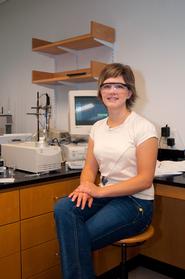
For the entirety of her senior year, Gail Corneau ’10 will be pursuing research that targets MRSA staph infections, an antibiotic-resistant staphylococcus infection that can be fatal if untreated. Hospitals researching Vancomycin, a last resort antibiotic used to treat MRSA infections, recently discovered that Vancomycin-resistant bacteria strains have emerged during testing.
Corneau, aided by her academic advisors Nicole Snyder (chemistry), Ashleigh Smythe, and Mike McCormick (both biology), has decided to devote her Senior Fellowship to investigating development of a Vancomycin derivative that incorporates an unnatural carbohydrate to overcome this bacterial resistance. Her project is titled “Seven-Membered and Sweet: Routes to Rational Antibiotic Design Using Unnatural Carbohydrates to Explore Antimicrobial Resistance in Staphylococcus Infections.”
Corneau began work on this project last summer as research assistant in Professor Snyder’s lab, and continued during the past spring semester as an independent study course. During that time, her work was predominately focused on organic synthesis. This year, she asserts that she will be focused “more on the biochemical aspects of the project.” She will work most closely on protein expression as well as binding studies.
Corneau’s ongoing research is divided into three parts. During the first stage of research, which she began last summer, she will examine the molecular structure of Vancomycin in order to create an unnatural seven-member carbon ring of its sugar component, Glycan. Septanoses are seven member carbon rings not ordinarily found in nature. By attaching a septanose to vancomycin, she is attempting to “confuse” staph bacteria, which will hopefully overcome their resistance to the antibiotic. In the next step of her project, she will test the binding affinity of the ring to protein or enzyme by synthesizing it and attaching it to Vancomycin. The third steps include binary studies of the product by binding penicillin-binding protein 2 with the two glycans she is completing synthsis on. This last step is followed by testing the component against MRSA staph infection.
The project’s multi-disciplinary nature is what most appealed to Corneau. A biochemistry major, she enjoys exploring the “interface between the project’s biological and chemical components.” For her project, Corneau has visited public hospitals to speak with infectious disease doctors. She is interested in hearing current policy on describing antibiotics and the implications it has for infectious diseases. Given the project’s health implications, she recognizes that it is a feasible subject area to possibly pursue post-graduation.
After graduation from Hamilton, Corneau hopes to apply to graduate school in an area that encompasses both biology and chemistry into its curriculum and research topics, and also includes “applications of the research to treating disease and helping to improve people’s health.” She is also considering the possibility of teaching in the future.
For Corneau, working on a Senior Fellowship is a valuable experience. She was drawn to the Senior Fellowship because “it allows students to conduct interdisciplinary research as well as giving them the freedom and time to develop their own project,” she said. Senior Fellows are exempt from taking a normal course load in the conventional curriculum, and they need not complete concentration requirements; as a result they may take such courses as are appropriate to their fellowship projects and their educational goals.
Corneau is the daughter of Susan and Keith Corneau of Ballston Lake and is a graduate of Shenendehowa Central School.
